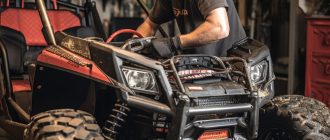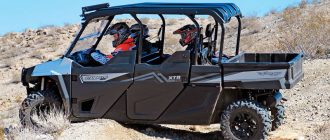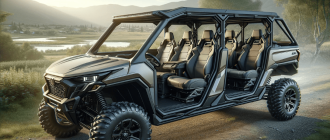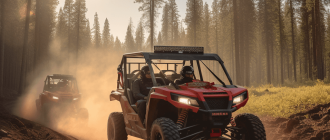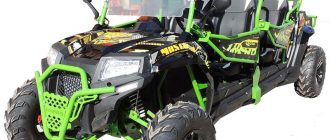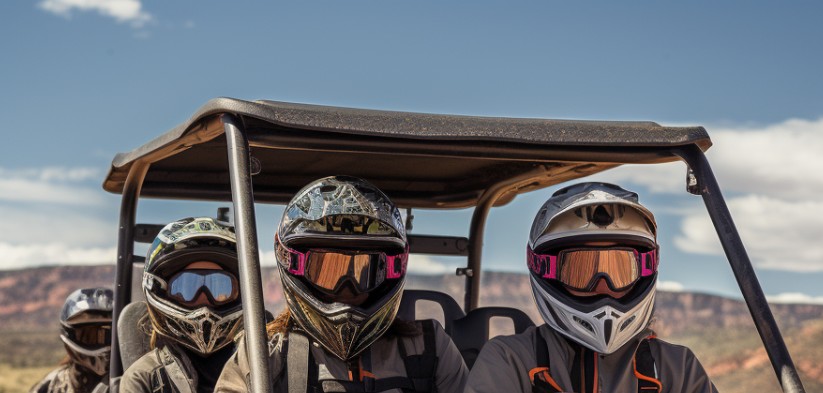
Essential Safety Practices and Gear Recommendations for 4-Seater UTV Enthusiasts: Stay Safe and Enjoy the Ride!
4-seater UTVs, or utility task vehicles, have gained immense popularity among outdoor enthusiasts in recent years. These powerful machines offer an exhilarating off-road experience for families and friends, allowing them to explore rugged terrains and enjoy the thrill of adventure. However, it is crucial to prioritize safety when operating a 4-seater UTV to prevent accidents and injuries. By following proper safety practices and equipping yourself with the right gear, you can ensure a safe and enjoyable off-road experience.
One of the most important safety practices for 4-seater UTV enthusiasts is wearing appropriate protective gear. This includes a DOT-approved helmet, goggles or a face shield, gloves, long-sleeved shirts, long pants, and sturdy boots. A helmet is essential to protect your head from potential injuries in the event of a rollover or collision. Goggles or a face shield will shield your eyes from dust, debris, and branches, ensuring clear vision. Gloves provide a better grip on the steering wheel and protect your hands in case of an accident. Long-sleeved shirts and pants safeguard your skin from cuts, abrasions, and sunburn, while sturdy boots offer ankle support and protection.
Another vital safety practice is always wearing seat belts while riding in a 4-seater UTV. Seat belts are designed to keep occupants securely in their seats, reducing the risk of ejection during sudden stops or rollovers. It is crucial for everyone in the vehicle to buckle up, including passengers in the back seats. Seat belts significantly increase the chances of survival and minimize the severity of injuries in the event of an accident.
In addition to wearing protective gear and seat belts, it is essential to follow safe driving practices when operating a 4-seater UTV. This includes driving at a safe and appropriate speed for the terrain, maintaining a safe distance from other vehicles, and avoiding sudden maneuvers. It is also crucial to be aware of your surroundings and watch out for obstacles, such as rocks, tree stumps, or uneven terrain. Always stay on designated trails and avoid driving on private property or environmentally sensitive areas.
By adhering to these safety practices and equipping yourself with the recommended gear, you can enjoy the excitement of off-roading in a 4-seater UTV while minimizing the risks. Remember, safety should always be the top priority, ensuring that you and your loved ones can continue to enjoy the thrill of adventure for years to come.
Essential Safety Features of Modern UTVs
When it comes to off-roading adventures, safety should always be the top priority. Modern UTVs (Utility Task Vehicles) are equipped with a range of essential safety features to ensure a secure and enjoyable ride for enthusiasts. Here are some of the key safety features found in modern UTVs:
1. Roll Cage: A robust roll cage is a vital safety feature in UTVs. It provides a protective frame around the vehicle’s occupants, helping to prevent injuries in the event of a rollover or collision.
2. Seatbelts: UTVs come equipped with seatbelts for each occupant. These seatbelts are designed to keep riders securely in their seats and reduce the risk of ejection during rough terrain or accidents.
3. Safety Nets or Doors: Many modern UTVs feature safety nets or doors that provide additional protection for riders. These features help to keep limbs inside the vehicle and reduce the risk of injury from debris or obstacles.
4. Overhead Protection: Some UTV models come with an overhead protection structure, such as a roof or canopy. This feature shields occupants from falling objects, sun exposure, and adverse weather conditions.
5. Fire Extinguisher: UTVs should always be equipped with a fire extinguisher. This essential safety equipment helps to quickly extinguish any potential fires that may occur during off-roading adventures.
6. Skid Plates: Skid plates are installed on the underside of UTVs to protect vital components, such as the engine and transmission, from damage caused by rocks, logs, or other obstacles.
7. Safety Decals or Labels: Manufacturers often include safety decals or labels on UTVs to provide important information, such as weight limits, operating instructions, and potential hazards.
8. Lighting Systems: UTVs are equipped with headlights, taillights, and turn signals to ensure visibility and enhance safety, especially during low-light conditions or when driving on public roads.
9. Ergonomic Design: Modern UTVs are designed with ergonomics in mind, providing comfortable seating positions, easy-to-reach controls, and clear visibility to minimize driver fatigue and improve overall safety.
10. Suspension and Tires: UTVs are equipped with robust suspension systems and durable tires to handle various terrains and provide a smooth and controlled ride, reducing the risk of accidents or rollovers.
It is crucial for UTV enthusiasts to familiarize themselves with these essential safety features and ensure that their vehicles are properly maintained and inspected. By prioritizing safety and using recommended gear, UTV enthusiasts can enjoy their off-roading adventures with peace of mind.
Innovations in UTV Safety Technology
As the popularity of UTVs continues to grow, manufacturers are constantly working to improve the safety features and technology available for these vehicles. From advanced roll cage design to cutting-edge safety systems, there have been several notable innovations in UTV safety technology in recent years.
One major advancement in UTV safety technology is the development of electronic stability control (ESC) systems. These systems use sensors to monitor the vehicle’s movement and automatically apply the brakes and adjust engine power to help maintain stability and prevent rollovers. ESC can be especially helpful in challenging terrain or during sudden maneuvers, providing UTV enthusiasts with an extra layer of protection.
Another important innovation is the incorporation of advanced seat belt systems in UTVs. Traditional lap belts have been replaced with three-point seat belts that include a shoulder harness. These seat belts help to keep passengers securely in their seats during off-road adventures, reducing the risk of injury in the event of a collision or rollover.
Roll cage design has also seen significant improvements in recent years. Many UTVs now come equipped with reinforced roll cages that are designed to withstand impacts and protect occupants in the event of a rollover. Some manufacturers have even introduced automatic deployable roll cages that can sense when the vehicle is about to roll and quickly extend to provide additional protection.
UTV safety technology has also embraced the use of advanced lighting systems. LED light bars and spotlights have become popular additions to UTVs, providing increased visibility during nighttime rides. These powerful lights help drivers spot potential hazards and obstacles, improving overall safety.
In addition to these advancements, UTV manufacturers have also focused on improving suspension systems to enhance safety. Upgraded suspension systems help to absorb shocks and bumps, providing a smoother ride and reducing the risk of passenger ejection or vehicle instability on rough terrain.
Overall, the innovations in UTV safety technology have greatly improved the safety and reliability of these vehicles. Whether it’s through the implementation of advanced stability control systems, improved seat belts, reinforced roll cages, enhanced lighting, or upgraded suspension systems, UTV enthusiasts can now enjoy their off-road adventures with greater peace of mind.
Importance of Roll Cages and Seatbelts
When it comes to off-roading in a 4-seater UTV, safety should always be the top priority. One of the most crucial safety features that every UTV enthusiast should have is a roll cage. A roll cage is a metal structure that surrounds the occupants of the UTV and provides protection in the event of a rollover or other accidents.
The roll cage is designed to absorb and distribute the impact of a rollover, reducing the risk of injury to the occupants. It acts as a protective cage, keeping the passengers safe from being crushed or trapped under the UTV in case of a rollover. Without a roll cage, the risk of serious injury or even death in a rollover accident increases significantly.
In addition to a roll cage, seatbelts are another crucial safety feature that should never be overlooked. Seatbelts keep the occupants securely in their seats and prevent them from being ejected during a rollover or collision. They help to minimize the risk of serious injury by keeping the occupants inside the UTV, rather than being thrown out and potentially crushed by the vehicle or other objects.
It is important to ensure that the seatbelts are properly fastened and adjusted to fit snugly. Loose or improperly fastened seatbelts can reduce their effectiveness in preventing injury. It is also recommended to wear helmets and other protective gear for added safety.
Uthe importance of roll cages and seatbelts cannot be overstated when it comes to off-roading in a 4-seater UTV. These safety features are designed to protect the occupants in the event of a rollover or other accidents, reducing the risk of serious injury or even death. Always prioritize safety and make sure to have a properly installed roll cage and wear seatbelts every time you hit the trails.
Vehicle Stability and Anti-Rollover Systems
When it comes to off-roading in a 4-seater UTV, vehicle stability is of utmost importance. The rugged terrains and unpredictable conditions can increase the chances of rollovers, making it crucial to have proper safety measures in place.
One important feature to look for in a 4-seater UTV is a reliable anti-rollover system. This system is designed to detect the vehicle’s stability and make necessary adjustments to prevent rollovers. It typically works by utilizing sensors that monitor the vehicle’s pitch, roll, and yaw, and applying corrective measures when needed.
Some UTV models come equipped with electronic stability control (ESC) systems, which are designed to help the driver maintain control of the vehicle during challenging driving conditions. These systems use a combination of sensors, brakes, and engine power reductions to help stabilize the vehicle and prevent it from rolling over.
Another important component of vehicle stability is the suspension system. A well-designed suspension system can help absorb shocks and vibrations, keeping the vehicle stable and reducing the risk of rollovers. It is important to choose a 4-seater UTV with a suspension system that is specifically designed for off-road use and can handle the demands of rough terrains.
In addition to having a reliable anti-rollover system and suspension system, it is also important to practice safe driving techniques. This includes driving at a safe speed, avoiding sharp turns or sudden maneuvers, and keeping a safe distance from other vehicles. It is also essential to wear proper safety gear, such as helmets, seat belts, and protective clothing, to minimize the risk of injury in the event of a rollover or other accidents.
Remember, vehicle stability and anti-rollover systems are essential for off-roading in a 4-seater UTV. Investing in a UTV with these safety features and practicing safe driving techniques can help ensure a fun and safe off-roading experience for everyone.
Personal Protective Equipment (PPE) for Riders
When it comes to riding a 4-seater UTV, it’s important to prioritize safety. One of the most effective ways to ensure your safety is by wearing the appropriate personal protective equipment (PPE). Here are some essential pieces of gear that every rider should have:
- Helmet: A high-quality helmet is an absolute must-have for any UTV rider. It should be DOT-approved and properly fitted to provide maximum protection in case of an accident.
- Eye Protection: Goggles or a full-face helmet with a visor are essential to protect your eyes from dust, debris, and other flying objects.
- Protective Clothing: Wearing durable, long-sleeved shirts, long pants, and sturdy boots can help protect your skin from scratches, cuts, and other injuries.
- Gloves: Gloves provide a better grip on the handlebars and protect your hands from blisters and abrasions.
- Knee and Elbow Guards: These guards can provide extra protection to your joints in case of a fall or collision.
- Neck Brace: A neck brace can help prevent neck injuries by limiting excessive movement of the head during falls or impacts.
- Back Support: Wearing a back support belt can help reduce the risk of back injuries and provide additional support during long rides.
It’s important to invest in high-quality PPE and regularly inspect and maintain your gear to ensure it remains in good condition. Remember, wearing the appropriate PPE is not only about legal requirements but also about your personal safety. Don’t take any chances when it comes to protecting yourself while enjoying your UTV adventures!
The Non-Negotiable: Helmets and Eye Protection
When it comes to riding a 4-seater UTV, safety should always be your top priority. One of the most important safety gear items that should never be negotiable is a helmet. Wearing a helmet while riding a UTV can significantly reduce the risk of head injuries in case of an accident or rollover.
When choosing a helmet, make sure it is approved by a reputable safety standards organization, such as the Department of Transportation (DOT) or the Snell Memorial Foundation. Look for helmets that have a snug fit and a sturdy chinstrap to keep it securely in place during your ride.
In addition to a helmet, eye protection is also crucial. When you’re out on the trails, debris, dust, and insects can easily fly into your eyes, causing irritation or impairing your vision. To protect your eyes, invest in a pair of goggles or safety glasses that are designed specifically for off-road use.
Look for goggles or glasses that provide a wide field of vision and have lenses that are impact-resistant and scratch-resistant. It’s also a good idea to choose goggles or glasses with lenses that have anti-fog properties, especially if you plan on riding in humid or cold conditions.
Remember, wearing a helmet and eye protection should never be optional when riding a 4-seater UTV. It’s the best way to ensure your safety and the safety of your passengers while enjoying the thrill of off-road adventures.
Body Armor and Protective Clothing Essentials
When it comes to off-roading in a 4-seater UTV, safety should always be the top priority. One essential piece of gear that every enthusiast should invest in is body armor. Body armor is designed to provide protection to vital areas of the body, such as the chest, back, and shoulders.
There are various types of body armor available on the market, including chest protectors, back protectors, and shoulder protectors. Chest protectors are typically made of hard plastic or carbon fiber and are designed to absorb and distribute the impact of a collision or crash. Back protectors, on the other hand, are designed to protect the spine and are usually made of high-density foam or hard plastic. Shoulder protectors are important for protecting the shoulders from impact and are often integrated into chest protectors.
In addition to body armor, it is also important to wear protective clothing while riding a 4-seater UTV. Protective clothing includes items such as helmets, goggles, gloves, and boots. Helmets are crucial for protecting the head in the event of a crash or rollover, and they should always be worn when operating a UTV. Goggles are essential for protecting the eyes from dust, debris, and wind. Gloves provide grip and protection for the hands, while boots offer ankle support and protection.
When choosing protective clothing, it is important to look for items that are specifically designed for off-roading and UTV riding. These items are typically made with durable materials that can withstand the rigors of off-roading, such as abrasion-resistant fabrics and impact-resistant plastics. It is also important to ensure that protective clothing fits properly and is comfortable to wear, as ill-fitting gear can hinder movement and reduce effectiveness.
Ubody armor and protective clothing are essential for ensuring the safety of 4-seater UTV enthusiasts. Investing in high-quality body armor and protective clothing can greatly reduce the risk of injuries and provide added peace of mind while out on the trails.
Importance of Gloves and Proper Footwear
When it comes to off-roading in a 4-seater UTV, safety should always be a top priority. Two essential pieces of gear that should never be overlooked are gloves and proper footwear.
Gloves serve multiple purposes and provide important advantages for UTV enthusiasts. Firstly, they offer protection for your hands in case of an accident or collision. Gloves can help prevent cuts, scrapes, and burns that can occur while maneuvering through rough terrains.
In addition to protection, gloves also offer improved grip and control. When operating a UTV, having a firm grip on the steering wheel is crucial. Gloves with textured palms can provide better traction, allowing you to maintain control even in slippery or muddy conditions.
Furthermore, gloves can help absorb vibrations and reduce fatigue. Off-roading can be a bumpy and jarring experience, and the constant vibrations can lead to hand fatigue. Wearing gloves with padded palms can help minimize the impact and strain on your hands, allowing you to enjoy longer rides without discomfort.
Proper footwear is equally important for ensuring safety during UTV adventures. Off-road environments can be unpredictable, with various hazards such as rocks, branches, and uneven surfaces. Wearing sturdy and supportive footwear can help protect your feet from injuries and provide stability while driving.
Opt for closed-toe shoes or boots that offer ankle support and have non-slip soles. This will help prevent your feet from slipping off the pedals or getting caught on any debris. Additionally, footwear with reinforced toe caps can protect your toes from impact or compression, should an accident occur.
Remember, your hands and feet are essential for controlling and maneuvering the UTV. Investing in high-quality gloves and proper footwear is a small price to pay for the added protection and peace of mind they provide.
So, before you embark on your next off-road adventure, make sure to gear up with gloves and suitable footwear. Stay safe and enjoy the thrill of UTV riding!
Rider Safety Tips and Best Practices
When it comes to riding a 4-seater UTV, your safety should always be the top priority. Here are some essential safety tips and best practices to keep in mind:
1. Wear proper safety gear: Always wear a helmet, goggles, gloves, and protective clothing to safeguard yourself from potential injuries. Make sure your gear fits properly and is in good condition.
2. Follow manufacturer’s guidelines: Read and understand the owner’s manual provided by the manufacturer. Familiarize yourself with the UTV’s features, controls, and safety instructions.
3. Inspect the UTV before each ride: Before hopping on your UTV, perform a thorough inspection of the vehicle. Check the tires, brakes, lights, and any other components to ensure they are in proper working condition.
4. Ride within your limits: Know your skill level and ride accordingly. Do not attempt to ride on difficult terrains or perform stunts beyond your capabilities. Gradually increase the difficulty level as you gain more experience.
5. Always buckle up: Ensure that all passengers are wearing seat belts before starting the UTV. Seat belts are crucial in keeping everyone secure in case of sudden stops or accidents.
6. Stay alert and focused: Keep your eyes on the trail and constantly scan for any potential hazards. Avoid distractions such as using your phone or consuming alcohol while riding.
7. Maintain a safe distance: Keep a safe distance from other riders to avoid collisions. Maintain a safe following distance and always be aware of your surroundings.
8. Use proper handholds and footholds: Hold on firmly to the handholds and use the designated footholds when entering or exiting the UTV. This will help prevent falls and injuries.
9. Be aware of weather conditions: Check the weather forecast before heading out for a ride. Avoid riding in extreme weather conditions such as heavy rain, snow, or strong winds.
10. Ride with a buddy: It’s always safer to ride with a buddy or in a group. Having someone with you can provide assistance in case of emergencies and adds an extra layer of safety.
By following these rider safety tips and best practices, you can enjoy your 4-seater UTV rides with peace of mind, knowing that you are taking the necessary precautions to stay safe on the trails.
Understanding and Respecting UTV Capabilities
When it comes to enjoying the great outdoors on a 4-seater UTV, it’s important to understand and respect the capabilities of your vehicle. UTVs are designed to handle rough terrains and provide an exhilarating off-road experience, but they do have their limits.
First and foremost, it’s crucial to familiarize yourself with the manufacturer’s guidelines and specifications for your specific UTV model. This includes understanding the weight capacity, maximum speed, and recommended terrain for your vehicle. Exceeding these limits can put you and your passengers at risk and may cause damage to your UTV.
One of the key aspects to consider is the UTV’s suspension system. UTVs are equipped with specialized suspension systems that allow them to absorb shocks and maintain stability on uneven terrain. However, it’s important to remember that even the most advanced suspension system has its limits. Avoid taking your UTV on extreme terrains or attempting jumps that exceed the recommended capabilities of your vehicle.
Additionally, UTVs are not designed to be driven on public roads or highways. They lack the necessary safety features, such as seat belts, turn signals, and headlights, to ensure safe travel on paved roads. Always operate your UTV on designated off-road trails and adhere to any local regulations or restrictions.
Lastly, it’s important to respect the natural environment when enjoying your UTV. Stick to designated trails and avoid damaging vegetation or wildlife habitats. Be mindful of noise pollution and try to minimize disturbances to wildlife and other outdoor enthusiasts.
| Understanding and Respecting UTV Capabilities |
|---|
| 1. Familiarize yourself with the manufacturer’s guidelines and specifications. |
| 2. Understand the weight capacity, maximum speed, and recommended terrain for your UTV. |
| 3. Avoid taking your UTV on extreme terrains or attempting jumps beyond its capabilities. |
| 4. Do not drive your UTV on public roads or highways. |
| 5. Respect the natural environment and stick to designated trails. |
Techniques to Prevent Rollovers and Collisions
When operating a 4-seater UTV, it is crucial to prioritize safety and take measures to prevent rollovers and collisions. Here are some techniques to keep in mind:
1. Wear Seat Belts: Always wear your seat belt and ensure that all passengers do the same. Seat belts can significantly reduce the risk of ejection during rollovers or collisions, keeping you and your passengers securely in place.
2. Slow Down on Turns: One of the common causes of UTV rollovers is taking turns at high speeds. Reduce your speed when approaching a turn and be cautious while navigating sharp corners. This will help maintain stability and prevent the UTV from tipping over.
3. Avoid Overloading: Do not exceed the recommended weight capacity of your UTV. Overloading can make the vehicle unstable and increase the chances of a rollover. Be mindful of the weight distribution and ensure that the load is properly balanced.
4. Stay Alert: Always stay focused and attentive while operating a UTV. Be aware of your surroundings, including other vehicles, pedestrians, and obstacles. Avoid distractions, such as using your phone or consuming alcohol, as they can impair your judgment and reaction time.
5. Maintain a Safe Distance: Keep a safe distance between your UTV and other vehicles to avoid collisions. This is especially important when driving on off-road trails or in areas with limited visibility. Maintain a reasonable distance to allow for sudden stops or maneuvers if needed.
6. Use Proper Traction: Ensure that your UTV has appropriate tires for the terrain you are driving on. Using tires with good traction can help prevent skids and slides, reducing the risk of losing control and causing a rollover or collision.
7. Be Mindful of Weather Conditions: Weather conditions can greatly impact the safety of your UTV ride. Be cautious when driving in adverse weather, such as rain, snow, or strong winds. These conditions can affect traction and visibility, increasing the likelihood of accidents.
8. Take a Defensive Driving Approach: Adopt a defensive driving approach by anticipating potential hazards and reacting proactively. Be prepared to adjust your speed, direction, and position to avoid collisions. Always yield to other vehicles and give them ample space.
9. Get Proper Training: If you are new to UTV driving or want to enhance your skills, consider taking a training course. Proper training can teach you essential techniques for safe UTV operation and help you understand the limitations and capabilities of your vehicle.
By following these techniques, you can minimize the risk of rollovers and collisions while enjoying your 4-seater UTV. Remember, safety should always be the top priority to ensure a fun and accident-free experience.
Significance of Rider Training and Awareness
When it comes to operating a 4-seater UTV, rider training and awareness are of utmost importance. These vehicles are powerful and can reach high speeds, making it essential for riders to have the necessary skills and knowledge to handle them safely.
Rider training programs offer a comprehensive education on the proper operation and handling of a UTV. These programs cover topics such as vehicle controls, maneuvering techniques, and safety precautions. By participating in a rider training course, enthusiasts can learn how to navigate different terrains, handle obstacles, and react to unexpected situations.
Not only does rider training improve a person’s technical skills, but it also enhances their awareness of potential dangers and risks. Riders are taught to constantly scan their surroundings, anticipate hazards, and make split-second decisions to avoid accidents. This heightened awareness can make a significant difference in preventing injuries and collisions.
Another benefit of rider training is the emphasis on proper safety gear. Participants are educated on the importance of wearing helmets, goggles, gloves, and other protective equipment. They learn how these items can prevent severe injuries in the event of a crash or rollover. Rider training programs also stress the importance of wearing appropriate clothing and footwear to ensure maximum comfort and protection.
By investing time and effort into rider training and awareness, enthusiasts can enjoy their 4-seater UTVs to the fullest while minimizing the risks associated with off-road riding. Whether it’s through formal training programs or self-education, riders should always strive to improve their skills and stay up-to-date with the latest safety practices.
Remember: Safety should always be the top priority when operating a 4-seater UTV. Proper rider training and awareness can make all the difference in ensuring a safe and enjoyable off-road experience.
Making Off-Roading Safer for Everyone
Off-roading is an exciting and adventurous activity enjoyed by many 4-seater UTV enthusiasts. However, it is important to prioritize safety to ensure a fun and accident-free experience for everyone involved. Here are some key practices and recommended gear to make off-roading safer:
1. Wear appropriate safety gear: Before hitting the trails, make sure to wear a properly fitting helmet, goggles, gloves, and durable off-road boots. These items will protect you from potential injuries and flying debris.
2. Inspect your UTV: Before each off-road adventure, thoroughly inspect your 4-seater UTV for any signs of wear and tear. Check the tires for proper inflation and tread depth, ensure all lights are working, and double-check that all safety features, such as seat belts and roll cages, are in good condition.
3. Follow designated trails: Stick to designated off-road trails and avoid venturing into unfamiliar or restricted areas. These designated trails are designed to minimize environmental impact and reduce the risk of accidents or damage to your UTV.
4. Drive at a safe speed: Off-roading can be thrilling, but it’s crucial to drive at a safe and controlled speed. Always be aware of your surroundings, slow down when encountering obstacles or difficult terrain, and avoid excessive speed that can lead to rollovers or collisions.

5. Communicate with fellow riders: Establish clear communication signals with your fellow riders before starting your off-road adventure. This will help ensure everyone is on the same page and can alert others of any potential hazards or changes in direction.
6. Carry essential safety equipment: Always have a well-stocked first aid kit, fire extinguisher, tow straps, and a tool kit on board. These items can come in handy in case of emergencies or breakdowns.
7. Respect the environment: Off-roading is a privilege, so be sure to respect the environment and follow all rules and regulations. Avoid littering, stay on designated trails, and be mindful of wildlife and natural habitats.
8. Stay hydrated and take breaks: Off-roading can be physically demanding, especially in extreme weather conditions. Stay hydrated by drinking plenty of water and take regular breaks to rest and recharge.
9. Continuously educate yourself: Stay updated on safety guidelines, techniques, and any changes in off-roading regulations. Attend safety courses, read up on off-roading best practices, and be open to learning from more experienced riders.
10. Be prepared for emergencies: Lastly, always be prepared for emergencies. Have a communication device, such as a two-way radio or cell phone, to call for help if needed. Familiarize yourself with the location and contact information of nearby medical facilities or off-road recovery services.
By following these safety practices and using the recommended gear, you can make off-roading a safer and more enjoyable experience for everyone involved. Remember, safety should always be the top priority when hitting the trails!
Legal Requirements for UTV Riding
When it comes to riding a UTV, it is important to be aware of the legal requirements in your area. These requirements are in place to ensure the safety of riders and others who may be sharing the trails or roads with UTVs. Here are some common legal requirements for UTV riding:
| Requirement | Description |
|---|---|
| Operator’s License | In most areas, a valid driver’s license is required to operate a UTV on public roads. Make sure you have the appropriate license before riding. |
| Registration | UTVs are often required to be registered with the local Department of Motor Vehicles (DMV) or a similar agency. This helps authorities keep track of UTVs and ensures they are being operated legally. |
| Insurance | Some areas may require UTVs to be insured, similar to other motor vehicles. Check with your local authorities to determine if insurance is mandatory for UTV riding in your area. |
| Helmet Laws | Many states have helmet laws that apply to UTV riders. Wearing a helmet can help protect you in the event of an accident, so it is always a good idea to wear one regardless of the legal requirements in your area. |
| Age Restrictions | There may be age restrictions for UTV riders, especially for those operating on public roads. Check the laws in your area to determine the minimum age for operating a UTV. |
| Equipment Requirements | UTVs are often required to have certain equipment, such as headlights, taillights, turn signals, and mirrors, to be operated legally on public roads. Make sure your UTV is equipped with the necessary items before hitting the road. |
It is important to familiarize yourself with the legal requirements for UTV riding in your area to avoid any potential fines or legal issues. Always ride responsibly and follow the rules of the road to ensure the safety of yourself and others.
The Role of Communication Devices in Group Safety
When it comes to enjoying the great outdoors in a 4-seater UTV, safety should always be the top priority. One crucial aspect of ensuring the safety of a group is effective communication. Communication devices play a vital role in keeping everyone connected and informed, especially when riding in a group.
Having a reliable communication device allows group members to stay in constant contact with each other, even when they are spread out over a large area. This can be particularly important when navigating unfamiliar terrains or encountering unexpected obstacles. With the ability to communicate instantly, group members can warn each other of potential dangers, share important information, or simply keep everyone updated on their location.
There are several communication devices available that are specifically designed for outdoor enthusiasts, such as two-way radios or Bluetooth headsets. Two-way radios are a popular choice for their long-range capabilities and ease of use. They allow group members to communicate with each other on the same frequency, ensuring clear and uninterrupted communication. Bluetooth headsets, on the other hand, offer a more hands-free option, allowing group members to communicate without having to hold a device.
In addition to facilitating communication within the group, communication devices can also be essential in case of emergencies. They enable group members to quickly call for help or notify authorities in case someone gets injured or encounters a serious problem. This can be especially crucial when riding in remote areas where cell phone reception may be limited or non-existent.
When using communication devices, it is important to establish clear communication protocols within the group. Group members should agree on specific channels or frequencies to use and establish a system of signals or codes for different situations. This will ensure that everyone is on the same page and can effectively communicate when needed.
| Benefits of Communication Devices in Group Safety |
|---|
| 1. Instant communication and coordination |
| 2. Increased situational awareness |
| 3. Ability to warn of potential dangers |
| 4. Quick access to assistance in case of emergencies |
| 5. Enhanced overall safety and peace of mind |
Environmental Awareness and Respectful Riding
As a 4-seater UTV enthusiast, it is important to be aware of the impact our riding activities can have on the environment. By practicing respectful riding and being mindful of our surroundings, we can help preserve the natural beauty of the areas we explore.
Here are some tips to promote environmental awareness while enjoying your UTV:
Stay on designated trails: Stick to established trails and avoid going off-roading in unauthorized areas. This helps protect sensitive habitats and prevents soil erosion.
Respect wildlife: Keep a safe distance from wildlife and observe them from afar. Do not disturb their natural behavior or habitat.
Minimize noise: UTVs can be loud, so be mindful of noise pollution. Avoid unnecessary revving of the engine, especially in residential areas or near wildlife habitats.
Dispose of waste properly: Pack out what you pack in. Do not leave any trash behind and dispose of waste in designated receptacles or take it with you.
Be mindful of vegetation: Avoid damaging vegetation by staying on designated trails and avoiding fragile plants. Do not drive over vegetation or disturb their growth.
Practice Leave No Trace principles: Follow the principles of Leave No Trace, which include leaving nature as you found it and minimizing your impact on the environment.
Share the road: Be respectful of other trail users, including hikers, bikers, and equestrians. Slow down, yield the right of way, and give them enough space.
Support conservation efforts: Consider joining or supporting local organizations that work towards preserving and protecting natural areas. Participate in clean-up events or volunteer your time to help maintain trails.
By practicing these environmental awareness tips, we can ensure that future generations can also enjoy the beauty of nature while riding our 4-seater UTVs.
Preparing for Different Riding Conditions
As a 4-seater UTV enthusiast, it is important to be prepared for various riding conditions to ensure your safety and the safety of your passengers. Here are some recommended safety practices and gear to consider:
- Always check the weather: Before heading out on your UTV, make sure to check the weather forecast for your riding area. Be prepared for changes in weather conditions and pack appropriate gear such as raincoats, extra layers, and sun protection.
- Familiarize yourself with the terrain: Different riding areas have different terrains, which may require specific safety precautions. Research and familiarize yourself with the terrain you will be riding on, and adjust your riding style accordingly. For example, if you will be riding on rocky terrain, consider using rock sliders or skid plates to protect the undercarriage of your UTV.
- Carry essential tools and equipment: It is always a good idea to carry a basic tool kit and essential equipment such as a first aid kit, fire extinguisher, and a portable air compressor. These items can come in handy in case of emergencies or minor repairs.
- Use appropriate tires: Depending on the terrain and weather conditions, you may need to switch to different types of tires. For example, if you will be riding in muddy conditions, consider using mud tires for better traction and control.
- Wear appropriate safety gear: Always wear a helmet, goggles, and protective clothing while riding your UTV. Additionally, consider wearing gloves, knee pads, and a chest protector for added safety. These protective gears can help minimize injuries in case of accidents or falls.
- Follow the rules and regulations: It is crucial to follow all local rules and regulations regarding UTV riding. This includes staying on designated trails, respecting private property, and adhering to speed limits. By following the rules, you not only ensure your safety but also contribute to maintaining the reputation of UTV enthusiasts.
By preparing for different riding conditions and following these safety practices, you can enjoy your 4-seater UTV adventures while minimizing the risks and ensuring a safe and enjoyable experience for everyone involved.
Adapting Protective Gear for Weather Variations
When it comes to enjoying your 4-seater UTV, it’s important to be prepared for any weather conditions you may encounter. Adapting your protective gear accordingly will ensure that you can stay safe and comfortable throughout your ride.
Rainy Conditions:
If you find yourself riding in the rain, it’s essential to have waterproof gear. Invest in a high-quality rain suit that is not only waterproof but also breathable to prevent sweating and discomfort. Don’t forget to wear waterproof gloves to keep your hands dry and maintain a good grip on the handlebars. Additionally, consider wearing goggles or a visor to protect your eyes from the rain and enhance visibility.
Cold Weather:
When riding in chilly temperatures, layering is key. Start with a moisture-wicking base layer to keep sweat away from your body, followed by a warm mid-layer such as a fleece jacket or thermal top. Top it off with a windproof and waterproof outer layer to protect yourself from the elements. Don’t forget to wear thermal pants or leggings under your riding pants to keep your legs warm. Insulated gloves and boots are also essential to keep your extremities protected from the cold.
Hot and Sunny Conditions:
In hot and sunny weather, it’s important to protect yourself from the sun’s harmful rays. Wear a lightweight, breathable long-sleeved shirt and pants to shield your skin from the sun. Opt for gear made from moisture-wicking materials to keep you cool and dry. Don’t forget to wear a wide-brimmed hat or a helmet with a visor to provide shade and protect your face from the sun. Lastly, apply sunscreen with a high SPF to any exposed skin to prevent sunburn.
Remember, regardless of the weather conditions, always wear a DOT-approved helmet and secure your seatbelts properly. Adapt your protective gear to the weather variations to ensure a safe and enjoyable UTV experience.
Gear and Tips for Reducing Rider Fatigue
Riding a 4-seater UTV can be an exhilarating experience, but it can also be physically demanding. Long hours on rough terrain can take a toll on your body and lead to fatigue. To ensure a comfortable and safe ride, it is important to have the right gear and follow some tips to reduce rider fatigue.
1. Comfortable Seats: Investing in seats that provide proper support and cushioning can make a big difference in reducing fatigue. Look for seats that have adjustable features and are designed to absorb shocks and vibrations.
2. Ergonomic Steering Wheel: Consider upgrading to a steering wheel that is ergonomically designed. This can help reduce strain on your arms and wrists, allowing for a more relaxed and comfortable grip.
3. Anti-Vibration Gloves: Vibration from the UTV can cause numbness and discomfort in your hands. Wearing anti-vibration gloves can help absorb some of the vibrations and reduce fatigue in your hands and arms.
4. Proper Suspension: A good suspension system can greatly reduce the impact of bumps and rough terrain. Upgrading your UTV’s suspension or adding aftermarket suspension components can provide a smoother and more comfortable ride.
5. Hydration System: Staying hydrated is essential for maintaining energy and reducing fatigue. Invest in a hydration system that allows you to easily drink water while riding, without having to stop and take off your gear.
6. Proper Body Positioning: Maintaining the correct body positioning while riding can help reduce fatigue. Keep your back straight, shoulders relaxed, and knees slightly bent. This helps distribute your weight evenly and reduces strain on your body.
7. Take Breaks: It’s important to take regular breaks during long rides to give your body a chance to rest and recover. Plan your rides with designated rest stops and take the time to stretch and relax.
8. Use Anti-Fatigue Mats: Anti-fatigue mats can be placed on the floor of your UTV to reduce the impact of vibrations and provide extra cushioning for your feet. This can help reduce fatigue and discomfort during long rides.
9. Wear Comfortable Clothing: Wearing comfortable and breathable clothing can help reduce fatigue and keep you cool during hot rides. Avoid wearing tight or restrictive clothing that can restrict movement and cause discomfort.
10. Listen to Your Body: Pay attention to your body and take breaks if you start feeling fatigued. Pushing through fatigue can increase the risk of accidents and injuries. Listen to your body’s signals and give yourself the rest you need.
By following these gear and tips for reducing rider fatigue, you can enjoy longer and more comfortable rides in your 4-seater UTV. Remember to prioritize safety and make sure to always wear appropriate safety gear.
Navigating Through Tough Terrain Safely
When it comes to off-roading in a 4-seater UTV, navigating through tough terrain safely is of the utmost importance. Here are some key tips to keep in mind:
1. Know your vehicle: Familiarize yourself with the capabilities and limitations of your UTV. Understand its ground clearance, suspension system, and overall handling. This knowledge will help you make informed decisions while navigating difficult terrain.
2. Use proper gear: Before heading out, make sure you are equipped with the necessary safety gear. This includes a helmet, goggles, gloves, and sturdy footwear. Wearing the right gear will protect you in case of any unexpected incidents.
3. Assess the terrain: Take the time to assess the terrain before attempting to navigate through it. Look for any potential hazards such as large rocks, tree stumps, or steep inclines. Plan your route accordingly to avoid these obstacles.
4. Maintain a steady speed: When tackling tough terrain, it is important to maintain a steady speed. Going too fast can lead to loss of control, while going too slow can cause your UTV to get stuck. Find the right balance and adjust your speed as needed.
5. Use proper technique: When navigating through tough terrain, it is crucial to use proper technique. This includes keeping a firm grip on the steering wheel, using the brakes and accelerator pedals smoothly, and keeping your body properly positioned within the vehicle.
6. Communicate with your passengers: If you have passengers in your UTV, establish clear communication with them. Let them know when you are about to encounter challenging terrain and instruct them on how to brace themselves for a smoother ride.
7. Be aware of your surroundings: Pay attention to your surroundings at all times. Keep an eye out for other vehicles, pedestrians, and wildlife. Be prepared to make quick decisions and take evasive action if necessary.
8. Don’t go alone: Whenever possible, it is best to go off-roading with a buddy or a group. Having someone else with you can provide assistance in case of an emergency and can make the overall experience safer and more enjoyable.
Remember, off-roading can be a thrilling and exhilarating experience, but safety should always be the top priority. By following these tips and using common sense, you can navigate through tough terrain safely and have a great time in your 4-seater UTV.
Q&A:
What safety practices should I follow when driving a 4-seater UTV?
When driving a 4-seater UTV, it is important to follow several safety practices. First, always wear a helmet and other protective gear, such as gloves and goggles. Second, make sure all passengers are wearing their seatbelts and are properly seated. Third, drive at a safe speed and be aware of your surroundings. Fourth, avoid driving under the influence of alcohol or drugs. Finally, be cautious when driving off-road and be aware of any potential hazards.
What gear do I need to have when driving a 4-seater UTV?
When driving a 4-seater UTV, there are several recommended gear items that you should have. First and foremost, you should always wear a helmet. Additionally, you should have gloves to protect your hands, goggles to protect your eyes from debris, and sturdy shoes to protect your feet. It is also a good idea to have a first aid kit, a fire extinguisher, and a winch in case you get stuck. Finally, it is important to have a spare tire and the necessary tools to change it in case of a flat.
Is it necessary to wear a helmet when driving a 4-seater UTV?
Yes, it is absolutely necessary to wear a helmet when driving a 4-seater UTV. Wearing a helmet can protect your head in case of a rollover or other accident. It can prevent serious head injuries and even save your life. Even if you are a skilled and experienced driver, accidents can happen, so it is important to always prioritize safety and wear a helmet.
Why should all passengers wear seatbelts in a 4-seater UTV?
All passengers should wear seatbelts in a 4-seater UTV for their own safety. Seatbelts can prevent passengers from being ejected from the vehicle in the event of a rollover or collision. They can help keep passengers in their seats and reduce the risk of serious injuries. It is important for all passengers to understand the importance of wearing seatbelts and to make sure they are properly fastened before the UTV starts moving.
What should I do if I get stuck while driving a 4-seater UTV?
If you get stuck while driving a 4-seater UTV, there are several steps you can take to try to get unstuck. First, assess the situation and determine the best course of action. If possible, try to back out of the stuck position. If that doesn’t work, you can try using a winch or a tow strap to pull yourself out. If all else fails, you may need to call for assistance or wait for help to arrive. It is important to remain calm and avoid making any sudden or reckless maneuvers that could worsen the situation.
What safety practices should I follow when driving a 4-seater UTV?
When driving a 4-seater UTV, it is important to follow several safety practices. First, always wear a helmet to protect yourself in case of an accident. Second, make sure all passengers are properly seated and wearing seat belts. Third, avoid driving in unsafe conditions such as extreme weather or rough terrain. Fourth, always follow the speed limits and drive at a safe and controlled pace. Finally, be aware of your surroundings and avoid any reckless or dangerous behavior.


